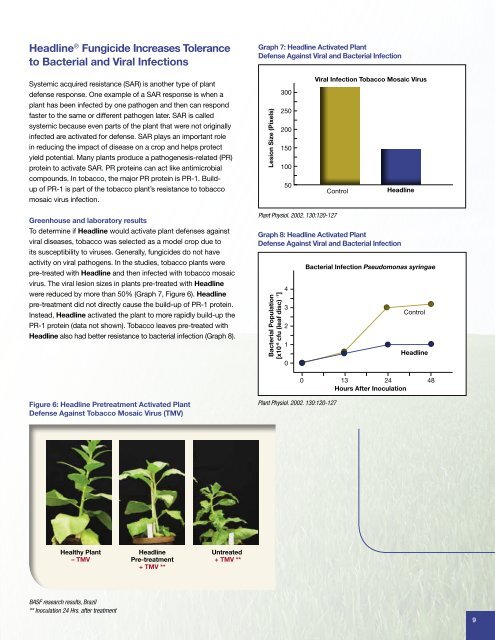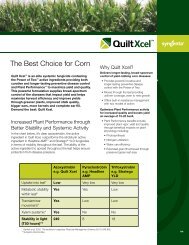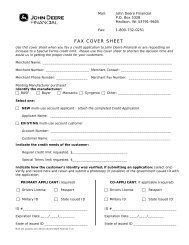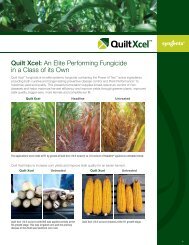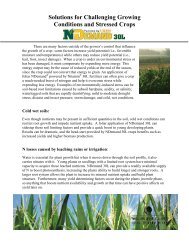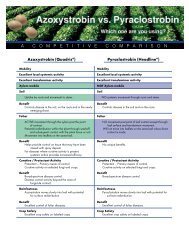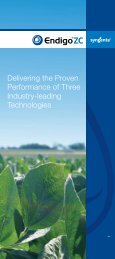Headline® Fungicide Plant Health Research Summary
Headline® Fungicide Plant Health Research Summary
Headline® Fungicide Plant Health Research Summary
You also want an ePaper? Increase the reach of your titles
YUMPU automatically turns print PDFs into web optimized ePapers that Google loves.
Headline ® <strong>Fungicide</strong> Increases Tolerance<br />
to Bacterial and Viral Infections<br />
Graph 7: Headline Activated <strong>Plant</strong><br />
Defense Against Viral and Bacterial Infection<br />
Systemic acquired resistance (SAR) is another type of plant<br />
defense response. One example of a SAR response is when a<br />
plant has been infected by one pathogen and then can respond<br />
faster to the same or different pathogen later. SAR is called<br />
systemic because even parts of the plant that were not originally<br />
infected are activated for defense. SAR plays an important role<br />
in reducing the impact of disease on a crop and helps protect<br />
yield potential. Many plants produce a pathogenesis-related (PR)<br />
protein to activate SAR. PR proteins can act like antimicrobial<br />
compounds. In tobacco, the major PR protein is PR-1. Buildup<br />
of PR-1 is part of the tobacco plant’s resistance to tobacco<br />
mosaic virus infection.<br />
Lesion Size (Pixels)<br />
300<br />
250<br />
200<br />
150<br />
100<br />
50<br />
Viral Infection Tobacco Mosaic Virus<br />
Control<br />
Headline<br />
Greenhouse and laboratory results<br />
To determine if Headline would activate plant defenses against<br />
viral diseases, tobacco was selected as a model crop due to<br />
its susceptibility to viruses. Generally, fungicides do not have<br />
activity on viral pathogens. In the studies, tobacco plants were<br />
pre-treated with Headline and then infected with tobacco mosaic<br />
virus. The viral lesion sizes in plants pre-treated with Headline<br />
were reduced by more than 50% (Graph 7, Figure 6). Headline<br />
pre-treatment did not directly cause the build-up of PR-1 protein.<br />
Instead, Headline activated the plant to more rapidly build-up the<br />
PR-1 protein (data not shown). Tobacco leaves pre-treated with<br />
Headline also had better resistance to bacterial infection (Graph 8).<br />
<strong>Plant</strong> Physiol. 2002. 130:120-127<br />
Graph 8: Headline Activated <strong>Plant</strong><br />
Defense Against Viral and Bacterial Infection<br />
Bacterial Population<br />
[x10 -6 cfu (leaf disc) -1 ]<br />
4<br />
3<br />
2<br />
1<br />
0<br />
Bacterial Infection Pseudomonas syringae<br />
Control<br />
Headline<br />
0 13 24 48<br />
Hours After Inoculation<br />
Figure 6: Headline Pretreatment Activated <strong>Plant</strong><br />
Defense Against Tobacco Mosaic Virus (TMV)<br />
<strong>Plant</strong> Physiol. 2002. 130:120-127<br />
<strong>Health</strong>y <strong>Plant</strong><br />
– TMV<br />
Headline<br />
Pre-treatment<br />
+ TMV **<br />
Untreated<br />
+ TMV **<br />
BASF research results, Brazil<br />
** Inoculation 24 Hrs. after treatment<br />
9


